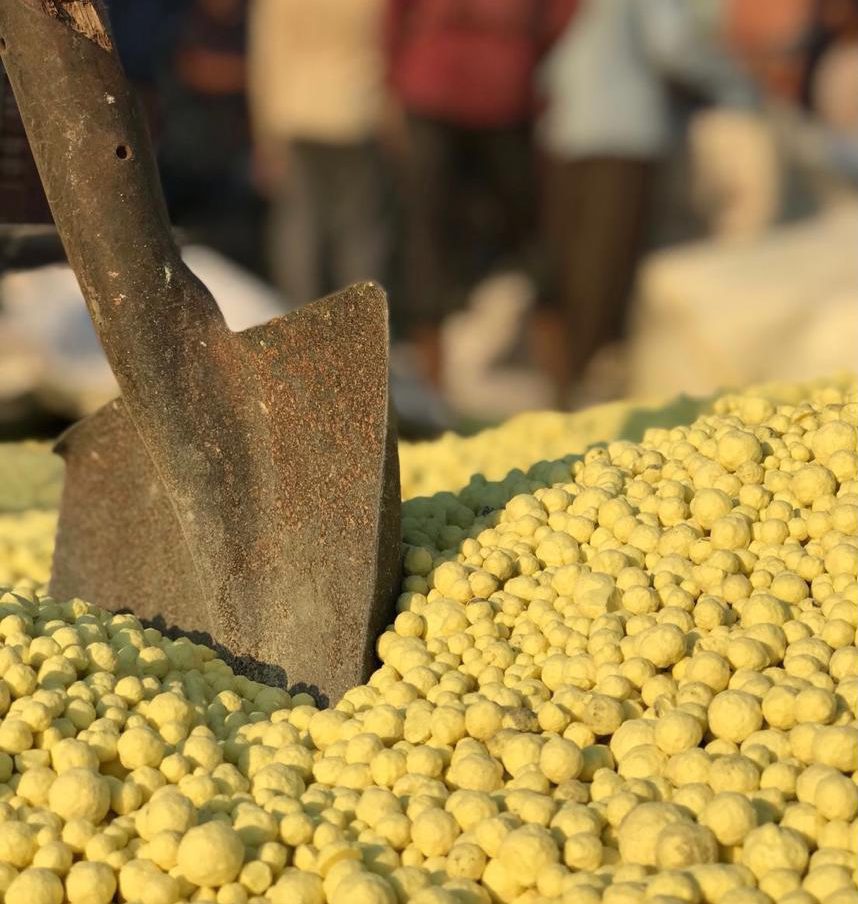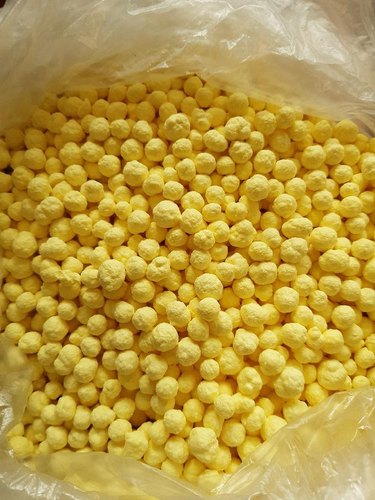General Description of Sulphur:
Sulfur is one of the most important agricultural and industrial raw materials and is considered a strategic product sulfur is an odourless, tasteless and polyvalent nonmetal which is mostly in the form of yellow crystals and is obtained from sulphide and sulphate.
Sulphur occurs naturally in the environment and is the thirteenth most abundant element in the earth’s crust. It can be mined in its elemental form, although this method has declined over the last decade to less than 2% of world production. Today most elemental sulphur is obtained as a co-product recovered from oil and gas production in sweetening process.
Sulfur (in British English: sulphur) is a chemical element with the symbol S and atomic number 16. It is abundant, multivalent and nonmetallic. Under normal conditions, sulfur atoms form cyclic octatomic molecules with a chemical formula S8. Elemental sulfur is a bright yellow, crystalline solid at room temperature.
Sulfur is the tenth most common element by mass in the universe, and the fifth most common on Earth. Though sometimes found in pure, native form, sulfur on Earth usually occurs as sulfide and sulfate minerals.
Being abundant in native form, sulfur was known in ancient times, being mentioned for its uses in ancient India, ancient Greece, China, and Egypt. Historically and in literature sulfur is also called brimstone, which means “burning stone”.
Sulphur is a multivalent non-metal, abundant. In its native form sulphur is a yellow crystalline solid. In nature it occurs as the pure element or as sulfide and sulfate minerals. Although sulphur is infamous for its smell, frequently compare to rotten eggs, that odor is actually characteristic of hydrogen sulphide (H2S).
The crystallography of sulphur is complex. Depending on the specific conditions, sulphur allotropes form several distinct crystal structures.
Today, almost all elemental sulfur is produced as a byproduct of removing sulfur-containing contaminants from natural gas and petroleum. The greatest commercial use of the element is the production of sulfuric acid for sulfate and phosphate fertilizers, and other chemical processes.
Sulphur is the primary source in the production of sulphuric acid, the world’s most widely used chemical. Sulphuric acid is an essential intermediate in many processes in the chemical and manufacturing industries. Sulphuric acid also is used by the fertilizer industry to manufacture primarily phosphates, nitrogen, potassium, and sulphate fertilizers.
Sulfur reacts directly with methane to give carbon disulfide, used to manufacture cellophane and rayon. One of the direct uses of sulfur is in vulcanization of rubber, where polysulfide chains crosslink organic polymers.
Large quantities of sulfites are used to bleach paper and to preserve dried fruit. Many surfactants and detergents (e.g. sodium lauryl sulfate) are sulfate derivatives. Calcium sulfate, gypsum, is mined on the scale of 100 million tonnes each year for use in Portland cement and fertilizers.
Sulphur is increasingly used as a component of fertilizers. Sulfur can be used in agriculture and various industries such as plastics and many synthetic products, paper, paint, etc.
The increasing demand from the fertilizer manufacturing sector, coupled with increasing usage of sulfur for vulcanization of rubber are the main factors driving the growth of the global sulfur industry.
Moreover, owing to the fall of crude prices, refineries across the globe are engaging in capacity expansion and other brownfield activities, leading to higher demand for sulfur. The demand for sulfur is also anticipated to be driven by the increasing usage of elemental sulfur as a major ingredient in the vulcanization process implemented to manufacture rubber.
However, the enactment of stringent environmental regulations restricting the usage of sulfur and the high costs associated with its mining, are the key factors hindering the sulfur market growth.
Three groups of sulfur are produced:
Sulfur powder:
Getting sulfur powder is typically at least a two-step process that starts with elemental, or mineral, sulfur; once this has been identified, it must be refined and ground down into a fine dust. Sulfur can be found in nature, and has traditionally been mined from volcanoes and salt domes.
In modern times the element is more readily collected as a residue or by product of petroleum mining and oil refining, though. The latter is sometimes strictly considered “natural” while the former called “synthetic,” but either will make a powder when processed.
Granules Sulphur:
The sulfur granules of actinomycosis and actinobacillosis were studied histologically and ultra-structurally. The sulfur granule of actinomycosis was large, and oval or horsehoe-shaped.In it, there were a number of gram-positive, filamentous or short rod-like hyphae beneath clubs.
Ultra structurally, the center of the sulfur granule was composed of a cluster of hyphae, and the periphery was surrounded by clubs arranged radially. The clubs were made of electron-dense fine granules and had a degenerated hypha at the center.
These granules varied in amount from small to large. As for the host reaction, neutrophil infiltration appeared first around the sulfur granule. Then epithelioid cells proliferated and phagocytized hyphae.
lump Sulfur:
Sulphur Lump is excessively required for a variety of applications in numerous industries such as Chemical industry.
We are actively engaged in offering the finest quality Sulphur Lump to our clients. As we believe in offering the best, we leave no stone unturned to acquire Sulphur Lump from the most reliable vendors only.
There are several allotropes of sulfur. The most common appears as yellow crystals or powder.
Uses of Sulfur:
Sulfur is used in the vulcanisation of black rubber, as a fungicide and in black gunpowder. Most sulfur is, however, used in the production of sulfuric acid, which is perhaps the most important chemical manufactured by western civilisations. The most important of sulfuric acid’s many uses is in the manufacture of phosphoric acid, to make phosphates for fertilisers.
Mercaptans are a family of organosulfur compounds. Some are added to natural gas supplies because of their distinctive smell, so that gas leaks can be detected easily. Others are used in silver polish, and in the production of pesticides and herbicides.
Sulfites are used to bleach paper and as preservatives for many foodstuffs. Many surfactants and detergents are sulfate derivatives. Calcium sulfate (gypsum) is mined on the scale of 100 million tonnes each year for use in cement and plaster.
Sulfur need to produce sulfuric acid. Phosphate fertilizers,rubber. Sulfur is used in produce fireworks, used in produce firecracker, fungicide. Sulfur used as a bleaching agent, disinfectant and refrigerant.
Improvement of saltines and alkaline soils of agriculture with the consumption of sulfur mineral fertilizers. Sulfur decrease PH agricultural soils/ farmer soils.
You can product the organic crop, organic vegetable, organic fruit with sulfur. Improve performance and product quality. When you use sulfur in your farming land, it’s possible for you that you can save water. Improvement of saltines and alkaline agriculture soils.
Sulfur is used to product : Sodium dithionite,Na2S2O,Sulfurous acid,H2SO3,Thiosulfates (S2O3-2>-),thionic acid (H2S2O6),polyphonic acids, (H2SnO6 ),Peroxymonosulfuric acid, peroxydisulfuric acids, Thiocyanogen,(SCN)2,Tetra sulfur tetra nitride S4N4.
Sulfur packing:
Packing weight Mineral sulfur: 25-50 kg bag Packing: Bulk or bag / 1MT jumbo bag
Specification of Sulfur:
| NO. | TEST | METHOD | Test Method |
| 1 | PURITY (ON DRY BASIC)(WT%)MIN | 99.50 | BS-4113 |
| 2 | Ash Content(WT%)MAX | 0.05 | BS-4113 |
| 3 | MOISTURE (WT%)MAX | 0.5 | BS-4113 |
| 4 | HYDROCARBONS(WT%)MAX | 0.05 | BS-4113 |
| 5 | ACIDITY (AS H2SO4) (WT%) | MAX 0.02 | ISO 3704 |
| 6 | BULK DENSITY Kg/M3 | MAX 1240 | ASTM D-1895 |
| 7 | Color | BRIGHT YELLOW | VISUAL |
| 8 | MESH SIZE 2-6 MM | MIN 90% | ISO 8397 |
| 9 | MESH SIZE >6.0 MM | MAX 10% | ISO 8397 |
| 10 | MESH SIZE <2.0 MM | MAX 10 % | ISO 8397 |






Good day,
I trust this message finds you well and safe.
My client is looking for producer or seller of Sulphur. Last destination is Nigeria. Quantity: 50,000 MT per month on a long-term contract. Specs are below for your review.
Specifications:
Bright Yellow Sulphur Crude in Bulk
Purity on dry basis 99.50% min.
Ash content 00.05% max.
Carbon Content 00.05% max.
Acidity 00.05% max.
Moisture 03.00% max.
Form Granular/ Prilled
Please do not hesitate to let me know shall you have any questions.
Looking forward to hearing from you if we can work together.
Fondly,
Khaled Tahoun